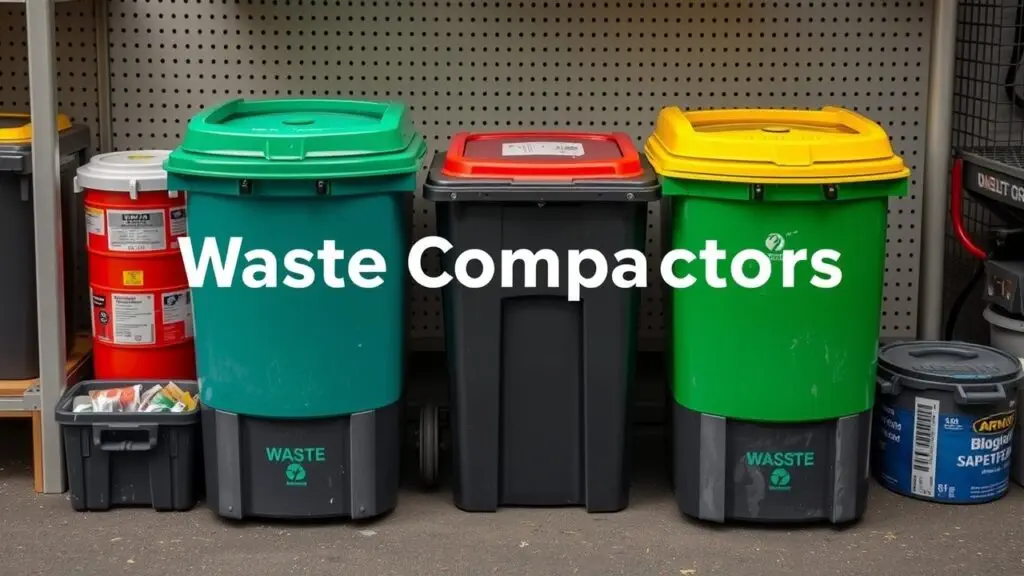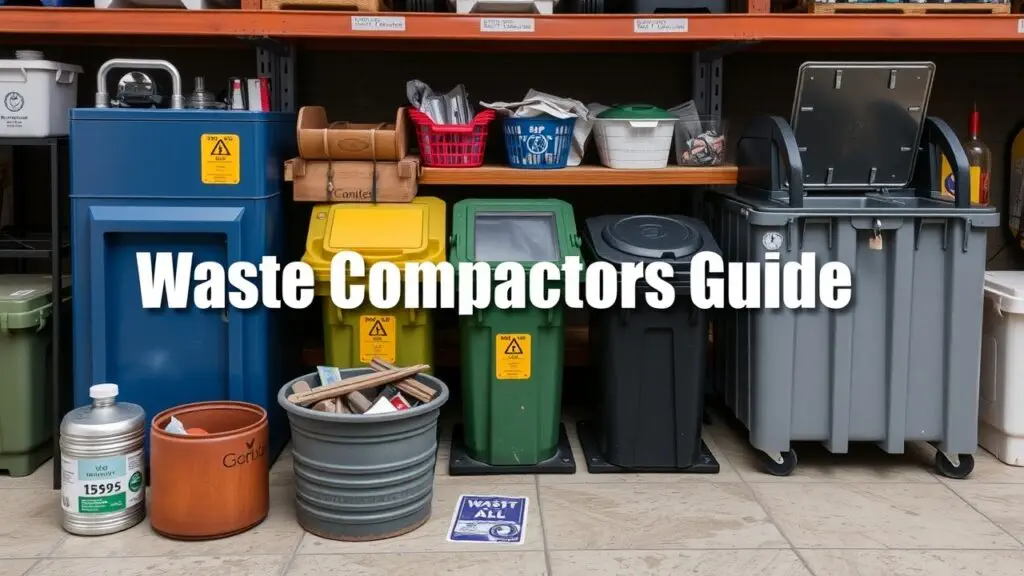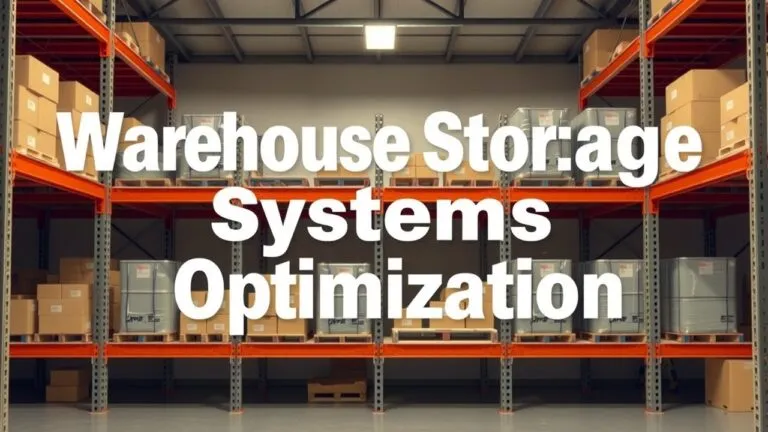Types of waste compactors vary greatly. This guide covers commercial and industrial options to help you choose the right system for your waste management needs.
What Are Waste Compactors?

Waste compactors are machines that help reduce the amount of waste we have. They work by compressing different kinds of waste into smaller bundles or bales. This makes it easier to handle and dispose of the trash. Waste compactors are used in many places like restaurants, retail stores, factories, and even at home. They help save space, which is really important.
For example, restaurants often have a lot of food waste. By using a waste compactor, they can make that waste smaller and easier to get rid of. Retailers deal with a lot of cardboard too. A compactor helps them manage that cardboard before recycling.
Why Choosing the Right Type Matters?
Picking the right compactor can really boost how well a business runs. It can save money on disposal costs and transportation fees. A good choice also means using space better in buildings, which is good for safety and the environment because it cuts down on what goes into landfills.
For instance, if a small business uses a self-contained compactor, it can manage mixed waste without taking too much room. This leads to savings over time because they won’t need collections as often and their landfill fees will be lower.
Overview of Types Covered
In this guide, we’ll look at several main types of waste compactors:
- Vertical Balers: Great for high-volume jobs focusing on recyclables like cardboard and plastics.
- Horizontal Balers: Similar to vertical balers but fit better in low-height areas.
- Self-Contained Compactors: Perfect for small businesses or offices with mixed waste.
- Stationary Compactors: Ideal for larger operations needing strong systems for bulk waste.
- Pre-Crusher Compactors: Help crush bulky items before they are compacted.
- Portable Units: Good for jobs where flexibility is key.
Knowing about these different types helps people—like facility managers or business owners—make smart choices for their waste management solutions.
Types of Waste Compactors Explained
Vertical Balers
Vertical balers are a type of waste compaction equipment. They compress materials from the top down. These machines use a hydraulic mechanism to apply pressure, which helps create dense bales for easy transport and handling. The process involves putting waste into the machine. Then, it is compacted downwards and tied off with wire or strapping systems.
Ideal Applications
These balers work well in places like manufacturing plants and recycling centers. They efficiently handle large amounts of cardboard, plastics, and paper waste. Their design reduces storage needs, making them great for recycling.
Advantages & Disadvantages
A major plus of vertical balers is their high compaction ratio. This means they significantly reduce the volume of waste. However, they need more vertical space and often have higher upfront costs than other compactors. Knowing these benefits can lead to savings over time due to lower disposal fees.
Horizontal Balers
Horizontal balers compress materials in a different way—they do it horizontally! This makes them perfect for spaces where height is limited. These machines push material into a chamber, where it gets compressed into bales.
Best Use Cases
Horizontal balers are best for businesses that manage recyclable materials, like plastics or textiles. They handle various types effectively without needing much vertical space.
Pros & Cons Comparison
The compact design of horizontal balers allows for flexibility in placement. But they might not compress materials as tightly as vertical models do. It’s important to weigh these factors when choosing the right type.
Self-Contained Compactors
Self-contained compactors combine compaction and storage in one unit. They are smaller and designed for convenience in operations with less space.
Features Overview
Their size makes them ideal for offices or restaurants dealing with general mixed waste streams efficiently without needing major infrastructure changes.
Suitable Industries/Settings
You’ll find self-contained compactors in settings like restaurant garbage disposal or office waste management solutions. They provide an affordable option but may have capacity limits compared to larger models.
Stationary Compactors
Stationary compactors are big machines set up at fixed locations. They’re designed for large-scale waste disposal needs, like those found in industrial sites or municipal facilities.
These units are built to support high volumes of waste logistics. They are especially useful for construction site garbage disposal or managing municipal solid waste effectively in cities today.
Vertical Balers: High-Volume Waste Solutions
Vertical balers are machines that compact large amounts of recyclable materials. They press waste into bales, making it easier to move and store. Many businesses like retail stores, manufacturing plants, and recycling centers use these balers because they cut down waste volume significantly.
Mechanism Details
Vertical balers use hydraulic compactors to apply pressure on the waste. This pressure helps to reduce the size of materials. The compaction ratio is key; it shows how much the machine can shrink waste compared to its original size. For instance, a vertical baler might achieve a compaction ratio of 4:1 to 10:1 based on what type of material is being compressed.
When enough pressure is applied, the bale ejection process starts. This means the compressed bale gets pushed out through a side or back opening for easy removal. Reducing waste volume not only saves space but also cuts transportation costs since you can fit more material in each load.
Applications and Case Studies
Vertical balers have many uses in different industries:
- Recycling Equipment: These machines help recycling facilities manage cardboard, plastics, paper, and metals.
- Manufacturing Plants: Factories often create lots of scrap materials that vertical balers can compact before recycling.
Studies show that businesses using vertical balers improve their waste management and support sustainability by promoting recycling.
Pros and Cons Analysis
It’s good to look at both the benefits and downsides of using vertical balers:
Advantages:
- Space Efficiency: Compacting waste turns bulky items into easy-to-handle bales.
- Cost Savings: Reduces disposal fees since pickups are less frequent.
- Improved Safety: Less clutter means safer work areas with fewer hazards from loose debris.
Disadvantages:
- Initial Investment Cost: These machines can be expensive at first.
- Maintenance Requirements: Keeping them running well needs regular maintenance, which might cost extra.
By knowing these points, business owners can make smart choices about whether to go with vertical balers or other types of industrial waste compactors available today.
Selection Guide
Choosing the right compactor needs some thought:
- Waste Compactor Size: Look at your space to find out what size fits best.
- Waste Compactor Capacity: Check how much trash or recyclables you create each day or week. This helps you understand what capacity you need from your compactor.
Considering these factors along with the different types of waste compactors out there will help businesses select equipment that matches their needs while managing high-volume waste effectively.
Horizontal Balers: Space-Saving Efficiency
Horizontal balers are machines that compact large amounts of recyclable materials. They are great for businesses that want to save space while managing waste effectively. These machines work well in places where there isn’t much room. With the horizontal compression method, they create dense bales, which help lower storage needs and cut transportation costs.
Mechanism and Ram Designs
Horizontal balers use either hydraulic or pneumatic systems for their operation. Hydraulic compactors use fluid power to apply strong pressure, making it easy to crush materials tightly into bales. On the other hand, pneumatic compactors rely on air pressure. However, they often don’t compress materials as tightly as hydraulic versions. Knowing how these systems work can help when picking the best baler for your needs.
Applications and Examples
Many businesses that deal with recyclable materials find horizontal balers very useful. They can handle different types of waste easily. Here are some common uses:
- Cardboard compactors: These are used to process shipping boxes.
- Plastic compactors: Designed for PET bottles or film plastics.
Industries like retail, manufacturing, and distribution benefit a lot from these machines as they make handling industrial waste simpler while boosting recycling efforts.
Advantages and Drawbacks
When looking at different types of waste compaction equipment, like horizontal balers, it’s wise to consider both benefits and drawbacks.
Pros:
- They offer a high compaction ratio. This means they can greatly reduce the volume of waste compared to smaller units.
Cons:
- Horizontal balers usually need a higher initial investment than other options.
- Their complex machinery may require more maintenance over time.
Key Features to Consider
Choosing the right horizontal baler involves looking at several important features:
- Bale Size Selection Guide: Different operations may require specific bale sizes based on available storage.
- Throughput Capacity Assessment: Finding out how much material can be processed in a certain timeframe ensures productivity.
- Automation Features: Many modern models include automation options that help improve efficiency by lessening manual work.
By keeping these points in mind, business owners can choose a baler that best fits their needs and helps them manage recyclables effectively while being cost-efficient.
Self-Contained Compactors: Compact Solutions for Smaller Businesses
Operational Details
Self-contained compactors are machines that combine the compactor and container into one unit. This design helps businesses manage their waste more efficiently, especially where space is limited. They work well for commercial trash and can handle both wet and dry waste.
These compactors compress the waste inside a sealed container. This prevents bad smells and keeps pests away. They come in various sizes, so smaller models can fit in tight spaces while still holding a good amount of trash.
Ideal Applications
Self-contained compactors are great for many types of businesses. Here are some common uses:
- Restaurant Waste Compactors: These units help with food scraps and packaging.
- Office Waste Management Solutions: They keep offices tidy by reducing how often pickups happen.
- Residential Waste Compactors: Perfect for apartment buildings with lots of garbage.
- Food Waste Compactors: Made specifically for organic material.
- Municipal Solid Waste Management: Handy in cities where space is tight.
These examples show how flexible self-contained compactors can be in different settings.
Pros and Cons
When looking at self-contained units, it’s important to think about their benefits and drawbacks:
Pros:
- Convenience: Their combined design makes waste management easier.
- Affordability: They usually cost less than larger models but still have enough capacity.
- Space-Saving Solutions: They fit well in smaller areas since they serve two purposes in one.
Cons:
- Limitations in Compaction Ratio: Smaller units might not pack waste as tightly as larger ones.
- Capacity Limitations: While good for small businesses, they might not handle larger amounts of trash.
Knowing these pros and cons helps business owners decide if a self-contained compactor is right for them.
Selection Criteria
Picking the best compactor involves several important points:
- Waste Compactor Size: Check your available space first; the model should fit without blocking anything.
- Capacity Considerations for Small Businesses: Think about how much waste you produce weekly to choose the right size—too small could lead to overflowing while too large might be a waste of money.
- Ease of Emptying & Maintenance Requirements: Look for features that make emptying easy; regular maintenance should be simple without taking too much time or cost.
By thinking through these factors, you can find a solution that meets your business’s needs while improving your waste management process.
Stationary Compactors: High-Capacity Industrial Solutions
Stationary compactors are crucial for waste management. These machines help with high-volume waste, making them perfect for businesses and industries that deal with a lot of trash. They’re fixed systems that efficiently compress large amounts of waste, which saves space and reduces disposal costs.
Operational Overview
Stationary compactors use a hydraulic system to crush waste into containers. This process cuts down the volume of materials, allowing more waste to fit in less space. Here’s how they work:
- Loading Mechanism: Waste can be loaded in different ways, like manually or using conveyor belts.
- Compaction Cycle: When the chamber is full, the hydraulic ram activates to compress everything inside.
- Container Management: Once full, the container is removed easily and replaced with an empty one.
These systems provide reliable performance while reducing labor costs linked to frequent waste pickups.
Ideal Applications
Stationary compactors shine in many large-scale operations because they are built tough and work efficiently. Here are some common places where you’ll find them:
- Industrial Facilities: Factories often produce lots of scrap material that need quick handling.
- Municipal Waste Management Solutions: Cities utilize stationary units at transfer stations to deal with household trash before it gets transported.
- Hospital Waste Compactors: Hospitals benefit by safely managing both hazardous and regular waste together.
- Restaurant Waste Compactors: Restaurants generate a lot of food scraps and packaging that need effective compression.
These machines work well in many settings that need reliable waste management solutions.
Advantages and Disadvantages
When looking at stationary units compared to mobile options, it’s good to know their pros and cons:
Benefits:
- Cost savings on disposal fees since less frequent pickups are needed.
- Space efficiency allows for more storage in tight areas.
- Enhanced safety as properly managed containers reduce hazards from overflowing trash bins.
Drawbacks:
- Higher initial investment compared to smaller mobile models.
- Limited mobility means relocating these machines can be tricky without careful planning.
Thinking about these factors helps business owners choose the right compactor for their needs.
Selection Considerations
Choosing the best stationary compactor involves several important factors:
- Capacity Considerations for Compactor Selection: Determine how much waste your facility generates each day; this will help you pick a model that has enough capacity.
- Infrastructure Integration for Stationary Units: Check if your site has enough space and access points for installation and consider if modifications are needed.
- Waste Type Compatibility with Static Machines: Different types of waste (like cardboard or organic material) may require specific features; make sure your choice matches what you need.
By looking closely at these aspects, you can find an industrial solution that meets your needs while helping you manage waste effectively.
Choosing the Right Waste Compactor: A Decision-Making Guide

Factors to Consider
When picking a waste compactor, you gotta think about a few important things. These factors help you find the right fit for your needs.
- Waste Compactor Size and Capacity: The size matters because it tells you how much waste it can hold. If you compact more waste at once, you don’t have to empty it as often. This saves time and money.
- Types of Waste Compactors: There are different types out there, like vertical balers, horizontal balers, and self-contained compactors. Each one works best depending on your space and waste management needs.
- Cost Savings from Waste Compactors: Buying a compactor can save you cash over time. It cuts down on how often you need to get trash collected and makes transporting waste cheaper due to less volume.
- Efficient Waste Management: A good compactor helps manage your waste better while supporting recycling efforts.
- Space-Saving Solutions: Some compactors are made to take up less room while still having high capacity. This is super helpful if your facility doesn’t have a lot of space for equipment.
- Sustainable Waste Management Practices: Choosing a model that helps with recycling or composting can make a positive impact on the environment.
Step-by-Step Decision-Making Process
Finding the right compactor takes some thought and research:
- Identify Your Needs: Figure out what kinds of materials you’ll throw away regularly.
- Research Options Available: Check out models for commercial trash compactors compared to those for home use.
- Ask Vendors Key Questions:
- How long will this model last?
- What does maintenance look like?
- Do you offer warranties or service plans?
- Compare Features Against Costs: Look at initial costs as well as operating expenses like energy use and repair costs over time.
- Make an Informed Choice Based on Data Collected.
Best Practices
Safety Precautions
Safety is super important when using waste compactors. Operators need training to keep everyone safe. They should know all the safety features of compactors, like emergency stops and safety guards. Lockout/tagout procedures help keep machines safe during maintenance. This means that machines are turned off and cannot start while being fixed.
Overfilling compactors can cause big problems, like damaging the machine or hurting someone. To avoid this, operators should check fill levels often and stick to the guidelines from the manufacturer about how much waste to put in. Setting clear rules for safe use can help keep the workplace secure.
Maintenance and Repair
Having a regular compactor maintenance schedule is key to keeping the equipment working well. This includes checking it regularly, cleaning it, oiling it up, and looking for leaks in hydraulic systems. Common issues include jams from foreign objects or mechanical failures from lack of care. It’s good to have troubleshooting steps written down clearly for easy reference.
Using genuine parts for repairs is really important because they fit the machine properly and keep it running efficiently. Using fake parts could cause more problems or void warranties, which isn’t good for anyone.
Waste Stream Optimization
To make waste management better, it’s essential to sort out recyclable materials correctly. By separating recyclables before they go into the compactor, businesses can recycle more while sending less to landfills.
It’s also smart to avoid oversized items that don’t fit well in standard compactors. Checking what kinds of materials are being processed often can lead to better ways of managing waste streams effectively.
Frequently Asked Questions (FAQs)
What are the different types of waste compactors?
Waste compactors come in various types. Some popular options include vertical balers, horizontal balers, self-contained compactors, and stationary compactors. Each type serves unique purposes based on the waste volume and material.
How do mobile waste compactors differ from stationary ones?
Mobile waste compactors offer flexibility. They can be moved easily to different locations. In contrast, stationary compactors remain fixed and are ideal for high-volume waste in one place.
What is a compaction ratio, and why does it matter?
The compaction ratio indicates how much a compactor reduces waste volume. A higher ratio means more efficiency in space management and reduced transportation costs.
What factors influence the cost of waste compactors?
The cost of waste compactors depends on size, type, features, and brand. Options range widely from smaller models to large industrial machines.
How important is maintenance for waste compactors?
Regular maintenance ensures that waste compactors operate efficiently. This helps prevent costly repairs and extends the equipment’s lifespan.
Where can I find a reliable supplier for waste compactors?
You can find suppliers through online research, industry recommendations, and trade shows. It’s important to check reviews for quality service and support.
Waste Compactor Types by Application
- Auger Compactors: Best for wet or sticky materials; they use screws for compaction.
- Garbage Compactors: Designed for general waste management; ideal for various environments.
- Recycling Compactors: Specialize in processing recyclable materials like cardboard and plastic.
- Two-Ram Compactors: Offer versatility with two compression rams; suitable for multiple material types.
- Open-End Auto-Tie Compactors: Allow easy loading; often used in recycling operations.
Waste Management Strategies
- Waste Reduction Strategies: Focus on minimizing waste generation before disposal.
- Waste Disposal Methods: Include landfilling, recycling, and composting; each method has its advantages.
- Environmental Impact of Waste: Effective management can significantly lower carbon footprints.
- Sustainable Waste Management Practices: Emphasize recycling and efficient resource use to protect the environment.
Compacting Equipment Features
- Compactor Containers: Used to hold compressed waste securely until disposal.
- Compactor Accessories: Include features like additional safety guards or automated controls.
- Smart Compactors: Utilize sensor technology to optimize efficiency and monitor usage.
- IOT Compacting Systems: Integrate technology for real-time data on compactor performance.
These points cover various aspects of waste compactors while incorporating remaining keywords relevant to your content.
Related Topics
- Types of Balers
- Types of Industrial Compactors
- Types of Commercial Compactors
- Types of Recycling Compactors
- Types of Waste Compaction Equipment
- Types of Waste Management Solutions
- Types of Waste Disposal Methods
- Types of Compactor Containers
- Types of Compactor Accessories



Types of Waste Compactors: A Guide to Commercial & Industrial Options